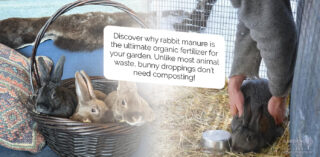Hare Today, Fertile Tomorrow! The Garden Magic of Rabbit Manure
Ah, rabbit manure!
Composted manure is the organic grower’s best gardening tool, and rabbit droppings are likely the most available manure.
The difference between kitchen scrap compost and manure is that manure, as organic matter in the garden, mainly when produced on-site, represents a system of plants and animals coexisting as nature intended. The nutrient content for plants can’t be beat. Compost is a closed loop in the kitchen, while manure turns the house into a homestead.


Hot and Cold
Most manure needs to be composted, mainly to reduce pathogens in the pile’s high heat. Composting also helps with nutrient availability. “Hot” manure, such as chicken or pig droppings, is too high in nitrogen and will burn your plants. Fortunately, hot manures compost rapidly; do not apply them raw.
Horse and cow dung are borderline hot manures; they’re more like cool manures. They also require composting to kill weeds and pathogens like E. coli, which can pass through the digestion of ungulates unscathed.
“Cold” manures are pelleted waste from goats and sheep and, of particular interest, rabbits. Goat and sheep droppings should still be aged due to the nitrogen content; however, rabbit poo, coming in at about 2-3% nitrogen, can be applied to the garden without composting!
Shitastic
Breeding rabbits on the homestead has surged in popularity for several reasons. For omnivores, lapin serves as a reliable food source. They reproduce, well, like rabbits, and they are relatively low maintenance. They are hardy to a variety of different weather conditions, you can repurpose their fur, and their poop is gold in the garden! ‘Bugs’ is easy to keep, and his poop doesn’t need composting. Work it into the soil to reduce odours and reduce fly pressure. Or mix it with water and apply it as a liquid fertiliser.
Understanding that bunnies make house pets can make some of this seem unsavoury. But not knowing where your food comes from is worse. Lapin or not, you could have a couple of same-sex bunnies for their manure. Due to their versatility, it is a no-brainer garden amendment, especially if balancing an array of inputs seems too complex. This helps you keep your garden clean and free from chemicals.
Rabbits are the low-hanging fruit of the animal husbandry world because they require no more space than a hutch and hay/greens for their feasting. A small backyard will do, or get creative. Grow a tower garden in your flat and share your hydroponic greens with your new fluffy friends!


Meet Kelci’s bunnies! @motherthealchemist
Kelci Stene Says
My friend Kelci Stene has a homestead on Gabriola Island, British Columbia, with her husband, young daughter, and many pets and animals, including ducks, chickens, and rabbits. They forage, trade, catch, grow, and raise their food. It’s all local, bountiful, nourishing, and healing!
Kelci speaks of gardens growing the lushest greens she’s ever seen off nothing more than sunshine, soil and bunny crap. But she does much more than talk if you’ve seen her garden. As a full-time mother and homesteader, her home is her work, and her life is her art.
She’s shared tips about housing rabbits for manure and meat, including using a wire floor for the hutch and hay for the bulk of their nutrition. She noticed she was losing hay through the flooring and created a hay feeder on one side of the hutch, where the rabbits pull hay through a chicken-wire-type enclosure, ensuring a consistent flow of food without waste.
Rabbits, like alpacas and llamas, tend to poop in the same place, making it easier to collect their droppings. With a wooden hutch raised off the ground and grate or wire flooring, figure out which corner the latrine is in and stick a litter box underneath!
“There’s a few different ways to use the green manure,” Kelci explains.
“You can sprinkle it on top of your crops or anywhere you want to fertilise your soil. The little round pellet poops act as a slow release fertiliser. You can also work it into the soil, or when you’re transplanting vegetables like squash, put a bunch in the hole and mix it in, then plant!”
Fur for Thought
I’m not saying you should eat your pet bunnies, though you may need to if global affairs continue the way they are (*nervous laughter*). Try working rabbit waste into the topsoil of your 3-5-gallon garden pots growing on the balcony, by the window or in the yard.
If you’re a young person who’s taken to the notion of pets as children and plants as pets, you’re surely looking for ways to expand the fam! Get some rabbits and maybe a few hundred red wiggler worms to join in on the fun of compost, soil, and regenerative gardening.




